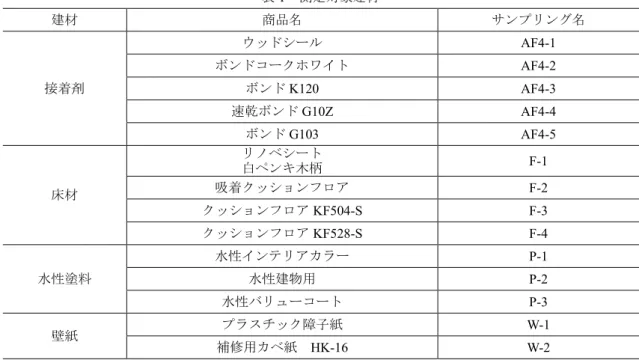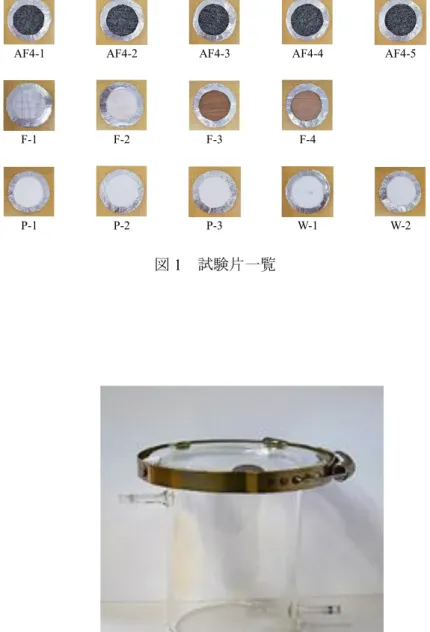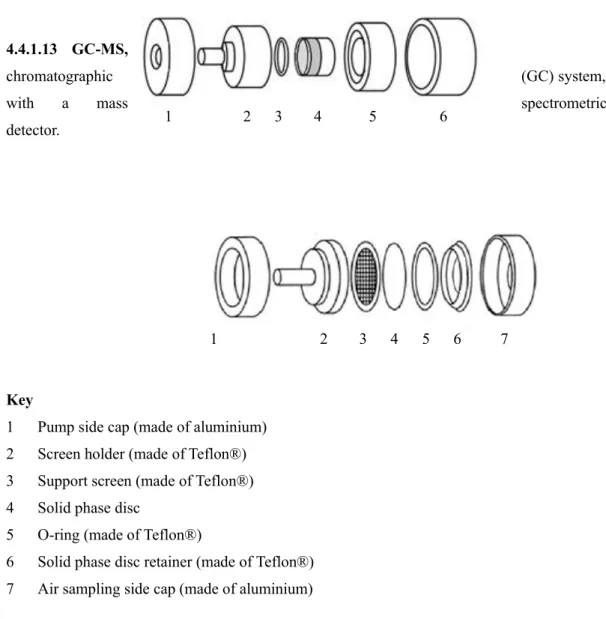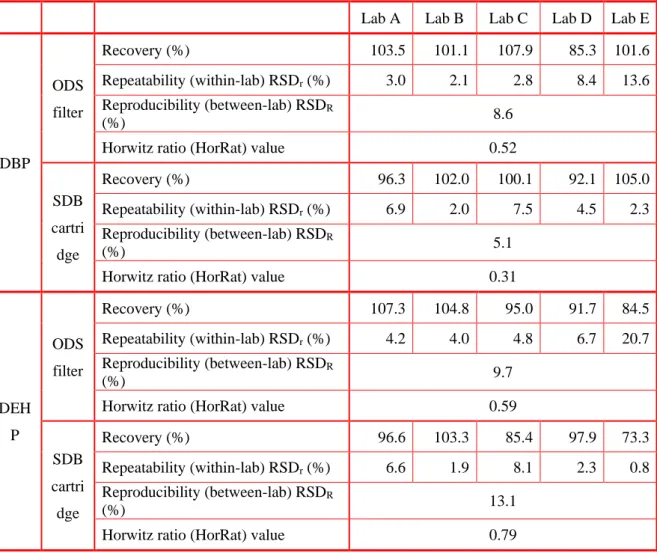156
厚生労働行政推進調査事業費補助金(化学物質リスク研究事業)
分担研究報告書
室内空気環境汚染化学物質の標準試験法の国際規格化
研究分担者 田辺 新一 早稲田大学創造理工学部建築学科 教授
厚生労働省のシックハウス(室内空気汚染)問題に関する検討会が開催され、指針値 の見直しや、新たな規制汚染物質が検討されている。また、フタル酸エステル類につ いて改正指針値に対応可能な標準試験法が提案され、日本薬学会編 衛生試験法・注
解2015:追補2019にて国内規格化や、国際規格にも新規案として提案されてる。本
分担研究では、国内に規格化されたフタル酸エステル類の測定・分析方法に対する国 際規格化や、室内における新たな汚染物質の放散源の探索のため、マイクロチャンバ ーを用いた仕上げ材からの SVOC 物質の放散速度を測定した。国内のフタル酸エス テル類の測定・分析方法を国際規格化するために ISO/TC146/SC6 の国際会議の状況 を総括した。フタル酸エステル類の測定と分析方法はWG20に該当するが、2019年 度はWG20 の会議が予定されなかったため、SC6 の総会で日本のフタル酸エステル 類の測定・分析方法を紹介した。その結果、発表資料はWG20のDocument資料とし て登録された。また、2019年度12月末まで国内のフタル酸エステル類の測定・分析
方法をISO-16000-33(フタル酸エステル類分析方法)の改正案として作成し、WG委員
長に提出した。今現在は改正案が検討されている。建材からの SVOC 放散速度を測 定した。測定対象建材は、接着剤5種類、床材4種類、水性ペイント3種類、壁紙2 種類であった。DBP、DOA、DEHP、TXIB はすべての建材から検出された。床材か らは特に2E1HとDEHPの放散速度が高く、また、水性ペイントからは2EH、DEHP、
TEXANOL、TXIB の放散速度が高く測定された。今後、水性ペイントの使用が多い
学校や病院における実態調査や、実験室実験による放散速度と気中濃度との相関性 を把握する必要があると考えられる。
A.研究目的
最近、厚生労働省のシックハウス検討 会では指針値設定・改定候補物質に対す る 意 見 と 方 針 が 検 討 さ れ 、 キ シ レ ン (200[μg/m3]) 、 DBP(17[μg/m3]) 、 DEHP (100[μg/m3]) の指針値が改正された。しか し、新規物質としては 2-エチル-1-ヘキサ
ノ-ル(2E1H)、2,2,4-トリメチル-1,3-ペンタ ン ジ オ-ル モ ノ イ ソ ブ チ レ-ト(別 名:Texanol)、2,2,4-トリメチル-1,3-ペンタ ンジオ-ルジイソブチレ-ト(別名:TXIB) が提案されたが、科学的な根拠やリスク 評価等、更なる知見が必要であることで 指針値には追加されなかった。
157 また、DBP、DEHPは最新の分析技術を 基に汎用性が高い標準試験法が開発され、
日本薬学会編 衛生試験法・注解 2015:
追補2019にて国内規格化される予定であ る。この試験法を国際規格に含むことが 検討されている。
本分担研究では、マイクロチャンバー を用いて建材からのSVOC 放散速度を測 定することで、既存の規制物質である DBP、DEHPのみではなく、新たに検討さ れているSVOC 物質の汚染源を把握する こととした。また、国内のフタル酸エステ ル類の測定・分析方法をISO/TC146(大気 の質)/SC6(室内空気)、ISO 16000-33:2017
「 Determination of phthalates with gas chromatography/mass spectrometry (GC/
MS)」に新規提案するための進捗情報を報 告する。
B. 研究方法
B-1 建材からのSVOC放散速度測定 1)測定概要
測定対象建材は、接着剤5種類、床材4 種類、水性ペイント3 種類、壁紙2 種類 である。これらの建材はホームセンター にて購入したものであり、一般によく使 用されている。表 1 に測定対象建材の種 類とサンプリング名を、図 1 に試験片の 写真を示す。接着剤 5 種類については、
アルミニウム板に 2 回塗った後、昨年度 測定の床材 F-4(2018)を接着し、1 週間以 上乾燥させてから測定を行った。接着剤 の種類は、AF4-1がアクリル樹脂エマルシ ョン系、AF4-2がアクリル樹脂系、AF4-3 が酢酸ビニル樹脂溶剤形、AF4-4がクロロ プレンゴム溶剤形、AF4-5がニトリルゴム
系溶剤形である。床材4種類については、
すべて塩化ビニルを使用しているPVC建 材である。水性ペイント 3 種類について は、アルミニウム板に2回塗った後、1週 間以上乾燥させてから測定を行った。水 性ペイントの種類は、P-1が水性アクリル エマルション塗料、P-2が水性シリコンア クリルエマルション樹脂、P-3が高性能シ リコンアクリル樹脂である。また、標準塗 り面積は、P-1が11~14㎡(1回塗り)、
P-2が11~15㎡(1回塗り)、P-3が11~
15㎡(1 回塗り)である。壁紙2 種類に ついては、W-1がポリビニルアルコール、
W-2が塩化ビニル樹脂である。
2)測定方法
図2にマイクロチャンバー外観を示す。
図3にマイクロチャンバー測定方法の工 程図を示す。マイクロチャンバーの容積 は630ml(±5%)であり、入口直前にベン トラインを設けることにより蓋と建材の 隙間から外気がチャンバーの中に入らな いようにコンタミ対策をしている。測定 開始前にマイクロチャンバーの解体し、
マイクロチャンバーを水で洗浄した。そ の後、チャンバー内に残存する化学物質 を揮発させるために加熱装置を用いて、1 時間220℃で加熱処理を行った。加熱処理 後、マイクロチャンバーを常温まで冷却 させた。
試験片をマイクロチャンバーの蓋と容 器の間に挟んで、試験片表面からのSVOC 物質放散測定を行った。マイクロチャン バー内に試験片を設置した時点で放散試 験の開始になる。放散試験は28℃の恒温 槽で24時間行った。放散試験後には加熱
158 脱着試験を行った。放散試験に使用した 試験片をチャンバーから取り外した後、
加熱脱着装置にマイクロチャンバーを設 置し、チャンバー内表面に付着している SVOCを加熱脱着した。加熱脱着は220℃、
1時間行った。加熱脱着されたSVOC物質 はTenax TA捕集管を用いて回収した。建 材からのSVOC放散速度は放散捕集と加 熱脱着捕集の結果を合算して総捕集量と した。表2に放散捕集試験の測定条件を、
表3に加熱脱着試験の測定条件を示す。
3)分析方法
分析対象物質は、2EH(2-エチルヘキサ ノール)、D6(ドデカメチルシクロヘキサ シロキサン)、BHT(ジブチルヒドロキシト ルエン)、DEP(フタル酸ジエチル)、C16(ヘ キサデカン)、TBP(リン酸トリブチル)、
TCEP(リン酸トリス(2-クロロエチル)、
DBA(アジピン酸ジブチル)、DBP(フタル 酸ジ-n-ブチル)、C20(n-イコサン)、TPP(リ ン酸トリフェニル)、DOA(アジピン酸ジオ クチル)、DEHP(フタル酸-2-エチルヘキシ ル)、2EHA(2-エチルヘキシルアクリレー ト)、TEXANOL(テ キ サ ノ ー ル )、 TXIB(2,2,4-トリメチル-1,3-ペンタンジオ ール ジイソブチラート)、DNOP(フタル 酸ジ-n-オクチル)、DINP(フタル酸ジイソ ノニル)、DIDP(フタル酸ジイソデシル)の 20種類の物質である。表4にTenax TA捕 集管の加熱脱着条件、表5にGC/MSの分 析条件を示す。
B-2 フタル酸エステル類の国際規格化 フタル酸エステル類の標準試験法を新 たに開発し、改正指針値に対応可能な標
準試験法を策定した。この試験法は日本 薬学会編 衛生試験法・注解 2015:追補 2019 にて国内規格化された。そこで、国 内のフタル酸エステル類の測定・分析方 法を ISO/TC146(大気の質)/SC6(室内空気)、
ISO 16000-33:2017「Determination of phthalates with gas chromatography/mass spectrometry (GC/MS)」に新規提案する ことを目指し、ISO/TC146/SC6の国際会議 で本件を紹介した。今年度の進捗情報を 報告した。
C. 研究結果
C-1 建材からのSVOC放散速度の結果 新しい規制の候補となっている化学物質 を含む19種類の化学物質を測定し、その 内放散速度が高いものを昨年度の測定結 果と合わせて図4から図11に示す。縦軸 が放散速度、横軸が測定対象建材を示し ている。また、昨年度と今年度の測定結果 を示している。
1) 2E1H
図 4 に2E1H の放散速度測定結果を示 す。2019 年度に測定した建材の中で放散 速度が最も高かったのは、床材 F-2 であ り、放散速度は39.46㎍/(㎡・h)であった。
接着剤AF4-1とA4F-2の放散が高く測定 されたが、床材F-4の測定結果より、放散 速度の測定値が下回っており、接着剤か らではなく、カーペットの F-4 の建材か らの放散でいると考えられる。また、床材 F-1の17.36㎍/(㎡・h)、水性ペイントP-2 と P-3 の 15.00 ㎍/(㎡・h)、壁紙 W-2 の 28.41㎍/(㎡・h)がその他の建材に比べ、高 い放散速度を示した。
159 2) DBP
図5にDBPの放散速度測定結果を示す。
2019 年度に測定した建材の中で放散速度 が最も高かったのは、壁紙W-1の0.87㎍ /(㎡・h)であった。接着剤AF4-2、AF4-4、
AF4-5は0.51~0.53㎍/(㎡・h)であるが、
2018年度の床材F-4の測定結果が0.61㎍ /(㎡・h)であるため、接着剤からの放散で はなく、F-4建材からの放散であることが 考えられる。一方、接着剤AF4-1 は0.69
㎍/(㎡・h)、AF4-3 は 0.66㎍/(㎡・h)であ り、床材F-4のみではなく、接着材からの 放散も考えられる。また、床材F-1の0.35
㎍/(㎡・h)、水性ペイント P-2 の 0.30 ㎍ /(㎡・h) がその他の建材に比べ、高い値で あった。
3) C20
図6にC20の放散速度測定結果を示す。
2019 年度に測定した建材の中で放散速度 が最も高かったのは、0.12㎍/(㎡・h)とな った壁紙W-1である。接着剤は他の建材 に比べ高い数値となっているが、2018 年 度の床材F-4の測定結果が0.55㎍/(㎡・h) であるため、接着材からの放散ではない と考えられる。また、床材 F-1 と F-4 の 0.11㎍/(㎡・h)、水性ペイントP-3の0.11
㎍/(㎡・h)、壁紙W-2の0.11㎍/(㎡・h)で あった。
4) DOA
図 7 に DOA の放散速度測定結果を示 す。2019 年度に測定した建材の中で放散 速度が最も高かったのは、水性ペイント
P-2であり、放散速度は0.87㎍/(㎡・h)で あった。また、水性ペイント P-1 の 0.46
㎍/(㎡・h)、壁紙W-2の0.54㎍/(㎡・h)が その他の建材に比べ、高く測定された。
5) DEHP
図8にDEHPの放散速度測定結果を示 す。2019 年度に測定した建材の中で放散 速度が最も高かったのは、床材 F-3 であ り、放散速度は30.78㎍/(㎡・h)であった。
また、床材F-2の22.10 ㎍/(㎡・h)、床材 F-4の19.73㎍/(㎡・h)が測定された。
6) 2,2,4-トリメチルペンタン-1,3-ジオ ールモノイソブチラート(TEXANOL)
図9にTEXANOLの放散速度測定結果
を示す。2019 年度に測定した建材の中で 放散速度が最も高かったのは、水性ペイ ント P-2 とP-3 であり、放散速度が 47.4
㎍/(㎡・h)以上となった。また、水性ペイ ントP-1の放散速度は14.2㎍/(㎡・h)であ り、その他の建材に比べ、高い値であった。
7) 2,2,4-トリメチル-1,3-ペンタンジオ ールジイソブチレート(TXIB)
図10にTXIBの放散速度測定結果を示 す。測定した建材の中で放散速度が最も 高かったのは、水性ペイントP-1であり、
放散速度が47.4㎍/(㎡・h)以上であった。
である。また、接着剤AF-3の18.15㎍/(㎡・
h)、水性ペイントP-3の11.1㎍/(㎡・h)が その他の建材に比べ、高い値となってい る。
8) DINP
図11にDINPの放散速度測定結果を示
160 す。2019 年度に測定した建材の中で放散 速度が最も高かったのは、10.3㎍/(㎡・h) となった壁紙W-2 である。その他の建材 からは検出されなかった。
C-2 フタル酸エステル類の国際化 ISO/TC146/SC6 の Working Group で議 論を行った。国際会議は2019 年10 月 7 日~11 日まで、ドイツ・ザンクトアウグ スティンで行われた。SC6の中、フタル酸 エステル類の分析方法は Working Group 20に該当するが、今回はWG20の会議が 開催されなかったため、10月11日のSC6 の総会で国内のフタル酸エステル類の測 定・分析方法を紹介した。
その結果、SC6 で発表した ppt 資料は Working Group 20のDocumentとして認定 された。また、掲載予定の英語論文も WG20に提出することにした。以上の内容 についてはWG20 のコンビーナ―である
Wensing博士から了解を得た。英語論文の
情 報 は 以 下 に 示 す 。Tanaka-Kagawa T., Saito I., Onuki A., Tahara M., Kawakami T., Sakai S., Ikarashi Y., Oizumi S., Chiba M., Uemura H., Miura N., Kawamura I., Hanioka N., Jinno H. Method validation for the determination of phthalates in indoor air by GC-MS with solid-phase adsorption/solvent extraction using octadecyl silica filter and styrene–divinylbenzene copolymer cartridge.
BPB Reports. 2019, 2 pp. 86–90
SC6の総会でResolution 456として、
以下の課題があった。国内のフタル酸エ ステル類の測定・分析方法を ISO 16000- 33:2017「Determination of phthalates with gas chromatography/mass spectrometry
(GC/MS)」に追加することを想定し、改正 案を作成し、2019年12月末に WG主査 に改正案を提出した。
D. 考察
D-1 建材からのSVOC放散速度の測定 建材による化学物質の放散量を把握し、
現在基準が設けられていない化学物質に ついて新しい基準を制定するため、その 根拠作りとして、マイクロチャンバー法 により準揮発性有機化合物の放散速度の 測定を行った。
DBP、DOA、DEHP、TXIBはすべての
建材から検出された。一方、DEP、TBP、
TCEP、DNOP、DIDPは全ての建材におい て検出限界値以下であった。床材からは 特に2E1H とDEHP の放散速度が高く、
床材の使用が多い学校やオフィスビルに おける実態調査が必要であると考えられ る。また、水性ペイントからは2EH、DEHP、
TEXANOL、TXIBの放散速度が高く、水
性ペイントの使用が多い学校や病院にお ける実態調査が必要である。
D-2 フタル酸エステル類の国際規格化 ISO 16000-33:2017「Determination of phthalates with gas chromatography/mass spectrometry (GC/MS)」には、空気、ハウ スダスト、表面のフタル酸エステル類濃 度の測定方法や、分析方法が規格されて いる。特に、空気中フタル酸エステル類の 測定は加熱脱着方法と溶媒抽出方法が掲 載されている。
国内のフタル酸エステル類の測定・分 析方法の規格は溶媒抽出方法であるため、
ISO 16000-33規格の中、4 Sampling methods
161 and analytical apparatus、4.3 Sampling by adsorption and subsequent solvent extraction の項目を用いて、4.4として、国内のフタ ル酸エステル類の測定・分析方法を追加 することが考えられる。また、詳細な情報 などが必要な場合は、Annex Xを作成する ことが必要である。以上の考察から日本 のフタル酸エステル類の測定・分析方法 を ISO 16000-33:2017「Determination of phthalates with gas chromatography/mass spectrometry (GC/MS)」に追加し、改正案 を作成した。改正案を付録に添付する。
E. 結論
E-1 建材からのSVOC放散速度の測定 室内で使用している建材から20種類の 化学物質に対する放散測定を行った。
2E1Hは全ての建材から放散された。また、
TXIB、TEXANOLは水性ペイント、PVC
建材、カーペットや断熱材から放散され、
今後室内の汚染物質として調査が必要で ある。特に、TXIB、TEXANOLは水性ペ イントから放散速度が高かったため、一 般住宅より水性ペイントをよく使用して いる教育施設、オフィス、病院施設などの 実態調査が必要であることや、実験室実 験などによる放散速度と気中濃度との相 関性を把握することが大事であると考え られる。
E-2 フタル酸エステル類の国際規格化 国内のフタル酸エステル類の測定・分 析方法を国際規格化のために国際会議に 参加した。国内のフタル酸エステル類の 測定・分析方法を ISO 16000-33:2017
「 Determination of phthalates with gas chromatography/mass spectrometry (GC/MS)」に追加するため、新草案を作成 している。2020年度前半にWG20の資料 として提出される予定である。また、審議 内容の確認とResolutionについては、2020 年度 9 月末にフランス・パリで行われる ISO/TC146/SC6で確認する。
F. 研究発表 1.論文発表
なし 2.学会発表
1) Hyuntae Kim, Shin-ichi TANABE, Makoto Koganei, The emission rate of newly regulated chemical substances from building materials, IAQVEC 2019,10th INT. conference on Indoor Air Quality, Ventilation and Energy conservation in building, Bair Italy USB #120、2019.9
2) 小谷菜緒、金 炫兌、田辺新一、小金井 真、建材から発生する未規制物質の放 散速度に関する調査、日本建築学会中 国支部研究発表会、2020.3(予定)
G. 知的所有権の取得状況 1.特許取得
なし
2.実用新案登録 なし
3.その他 なし
162 表一覧
表1 測定対象建材
建材 商品名 サンプリング名
接着剤
ウッドシール AF4-1
ボンドコークホワイト AF4-2
ボンドK120 AF4-3
速乾ボンドG10Z AF4-4
ボンドG103 AF4-5
床材
リノベシート
白ペンキ木柄 F-1
吸着クッションフロア F-2 クッションフロアKF504-S F-3 クッションフロアKF528-S F-4 水性塗料
水性インテリアカラー P-1
水性建物用 P-2
水性バリューコート P-3
壁紙 プラスチック障子紙 W-1
補修用カベ紙 HK-16 W-2
表2 加熱脱着試験の測定条件(MSTD-258M)
加熱脱着温度 30℃ (5min)-(20℃/min) -220℃ (40min)
供給ガス流量(He) 90 ml/min
吸引流量 60 ml/min
サンプリング時間 60 min
捕集管 Tanex TA(60/80 mesh)
表3 放散捕集試験の測定条件
チャンバー容積 630ml
時間 24h
吸引流量 30ml/s×24h=42.3L
ベント流量 15ml/s
MC供給流量 15ml/s
捕集管 Tenax TA(60/80mesh)充填
163
表4 加熱脱着の条件(GERSTEL TDS A)
加熱脱着条件 280 ˚C (10 min)
トラップ温度 -60 ˚C
注入温度 325 ˚C (5 min)
表5 GC/MSの分析条件
使用機器(GC/MS) Agilent 6890N / 5973 inert
カラム Inert Cap 1MS 30m×0.25mm×0.25μmdf
GC オーブン温度 50˚C(2min)→10˚C/min→320˚C(5min) スプリット比 低濃度:splitless、高濃度:50:1
測定モード SCAN
SCANパラメータ m/z 29(Low)~550(High)
検出器温度 230˚C
164 図一覧
AF4-1 AF4-2 AF4-3 AF4-4 AF4-5
F-1 F-2 F-3 F-4
P-1 P-2 P-3 W-1 W-2
図1 試験片一覧
図2 マイクロチャンバー外観
165
空気
(相対湿度50±5%)
クランプ
試験片
マイクロチャンバー 捕集ポンプ 捕集管
捕集管
捕集ポンプ
マイクロチャンバー 不活性ガス
クランプ
チャンバー加熱装置(200~220℃)
図 3 マイクロチャンバー測定方法の工程図
166
0 10 20 30 40 50 60 70 80 90
AF4-1 AF4-2 AF4-1 AF4-2 AF4-3 AF4-4 AF4-5 F-1 F-2 F-3 F-4 F-1 F-2 F-3 F-4 P-1 P-2 P-3 P-1 P-2 P-3 W-1 W-2 S-1
2018 2019 2018 2019 2018 2019 2019 2018
2EH[μg/(㎡・h)]
図4 2EH放散速度結果
0.00 0.10 0.20 0.30 0.40 0.50 0.60 0.70 0.80 0.90 1.00
AF4-1 AF4-2 AF4-1 AF4-2 AF4-3 AF4-4 AF4-5 F-1 F-2 F-3 F-4 F-1 F-2 F-3 F-4 P-1 P-2 P-3 P-1 P-2 P-3 W-1 W-2 S-1
2018 2019 2018 2019 2018 2019 2019 2018
DBP[μg/(㎡・h)]
図5 DBP放散速度結果
0.00 0.10 0.20 0.30 0.40 0.50 0.60 0.70
AF4-1 AF4-2 AF4-1 AF4-2 AF4-3 AF4-4 AF4-5 F-1 F-2 F-3 F-4 F-1 F-2 F-3 F-4 P-1 P-2 P-3 P-1 P-2 P-3 W-1 W-2 S-1
2018 2019 2018 2019 2018 2019 2019 2018
C20[μg/(㎡・h)]
図6 C20放散速度結果
167
0.00 0.10 0.20 0.30 0.40 0.50 0.60 0.70 0.80 0.90
AF4-1 AF4-2 AF4-1 AF4-2 AF4-3 AF4-4 AF4-5 F-1 F-2 F-3 F-4 F-1 F-2 F-3 F-4 P-1 P-2 P-3 P-1 P-2 P-3 W-1 W-2 S-1
2018 2019 2018 2019 2018 2019 2019 2018
DOA[μg/(㎡・h)]
図7 DOA放散速度結果
0 5 10 15 20 25 30 35
AF4-1 AF4-2 AF4-1 AF4-2 AF4-3 AF4-4 AF4-5 F-1 F-2 F-3 F-4 F-1 F-2 F-3 F-4 P-1 P-2 P-3 P-1 P-2 P-3 W-1 W-2 S-1
2018 2019 2018 2019 2018 2019 2019 2018
DEHP[μg/(㎡・h)]
図8 DEHP放散速度結果
0 5 10 15 20 25 30 35 40 45 50
AF4-1 AF4-2 AF4-1 AF4-2 AF4-3 AF4-4 AF4-5 F-1 F-2 F-3 F-4 F-1 F-2 F-3 F-4 P-1 P-2 P-3 P-1 P-2 P-3 W-1 W-2 S-1
2018 2019 2018 2019 2018 2019 2019 2018
TEXANOL[μg/(㎡・h)]
図9 TEXANOL放散速度結果
168
0 5 10 15 20 25 30 35 40 45 50
AF4-1 AF4-2 AF4-1 AF4-2 AF4-3 AF4-4 AF4-5 F-1 F-2 F-3 F-4 F-1 F-2 F-3 F-4 P-1 P-2 P-3 P-1 P-2 P-3 W-1 W-2 S-1
2018 2019 2018 2019 2018 2019 2019 2018
TXIB[μg/(㎡・h)]
図10 TXIB放散速度結果
0 2 4 6 8 10 12
AF4-1 AF4-2 AF4-1 AF4-2 AF4-3 AF4-4 AF4-5 F-1 F-2 F-3 F-4 F-1 F-2 F-3 F-4 P-1 P-2 P-3 P-1 P-2 P-3 W-1 W-2 S-1
2018 2019 2018 2019 2018 2019 2019 2018
DINP[μg/(㎡・h)]
図11 DINP放散速度結果
169
[付録]
Meeting of ISO/TC 146/SC 6
"Indoor air"
Sankt Augustin (Germany) 11 October 2019
Resolutions
Resolution 456
ISO/TC 146/SC 6 agrees that the Japanese delegation should prepare the documents on "Determination of phthalates with gas chromatography/mass spectrometry (GC/MS)" for further discussion and send them to the secretariat by the end of this year. The secretariat will distribute it to WG 20.
DRAFT Ver. 1.1
ISO 16000-33
Indoor air —
Part 33:
Determination of phthalates with gas chromatography/mass spectrometry (GC/MS)
Air intérieur —
Partie 33: Détermination des phtalates par chromatographie en phase gazeuse/spectrométrie de masse (CPG/SM)
170
Contents
Foreword Introduction 1 Scope
2 Normative references 3 Terms and definitions
4 Sampling methods and analytical apparatus 4.1 General
4.2 Sampling by adsorption with subsequent thermal desorption 4.2.1 Apparatus, operating materials and chemicals 4.2.2 Preparation of the thermal desorption tube 4.2.3 Sampling
4.3 Sampling by adsorption with Florisil®2) and subsequent solvent extraction 4.3.1 Apparatus, operating materials and chemicals
4.3.2 Preparation of Florisil®2) and the adsorption tubes 4.3.3 Hints to the application of Florisil®2)
4.3.4 Sampling
4.3.5 Sample conditioning
4.4 Sampling by adsorption with ODS solid phase disk or SDB copolymer cartridge and subsequent solvent extraction
4.4.1 Apparatus, operating materials and chemicals 4.4.2 Sampling
4.4.3 Test solution preparation 5 Calibration
5.1 General
5.2 Calibration of the thermal desorption method 5.3 Calibration of the solvent extraction method 6 Identification and quantification
6.1 Mass spectrometric analysis
7 Establishment of calibration curves and calculation of the analyte mass 7.1 Establishment of calibration curves
7.2 Calculation of the analyte mass 8 Calculation of indoor air concentrations 9 Performance characteristics
9.1 Detection limit
9.2 Quantification limit and problems related to the blank values
171
9.3 Reproducibility standard deviation and repeatability standard deviation 10 Quality assurance
10.1 Method verification and determination of blanks 10.1.1 Field blank value of the indoor air 10.1.2 Analytical laboratory blank value 10.2 Measures for blank value minimization 10.3 Documents
11 Interferences
Annex A (informative) General information on phthalates Annex B (informative) Screening phthalates in solvent wipe tests.
Annex C (informative) Screening phthalates in house dust
Annex D (informative) Practical example for the calibration of the thermal desorption method Annex E (informative) Practical example for the calibration of the solvent extraction method using Florisil®2)
Annex F (informative) Practical example for the gas chromatography with thermal desorption Annex G (informative) Practical example for the gas chromatography following solvent extraction
Annex H (informative) Problems related to the blank values
Annex X (informative) Interlaboratory validation study for ODS filter method and SDB cartridge method
Annex I (informative) Example of a sampling protocol Bibliography
172
Foreword
ISO (the International Organization for Standardization) is a worldwide federation of national standards bodies (ISO member bodies). The work of preparing International Standards is normally carried out through ISO technical committees. Each member body interested in a subject for which a technical committee has been established has the right to be represented on that committee.
International organizations, governmental and non-governmental, in liaison with ISO, also take part in the work. ISO collaborates closely with the International Electrotechnical Commission (IEC) on all matters of electrotechnical standardization.
The procedures used to develop this document and those intended for its further maintenance are described in the ISO/IEC Directives, Part 1. In particular the different approval criteria needed for the different types of ISO documents should be noted. This document was drafted in accordance with the editorial rules of the ISO/IEC Directives, Part 2 (see www .iso .org/ directives).
Attention is drawn to the possibility that some of the elements of this document may be the subject of patent rights. ISO shall not be held responsible for identifying any or all such patent rights. Details of any patent rights identified during the development of the document will be in the Introduction and/or on the ISO list of patent declarations received (see www .iso .org/ patents).
Any trade name used in this document is information given for the convenience of users and does not constitute an endorsement.
For an explanation on the voluntary nature of standards, the meaning of ISO specific terms and expressions related to conformity assessment, as well as information about ISO’s adherence to the World Trade Organization (WTO) principles in the Technical Barriers to Trade (TBT) see the following URL: www .iso .org/ iso/ foreword .html.
This document was prepared by Technical Committee ISO/TC 146, Air quality, Subcommittee SC 6, Indoor air.
A list of all parts in the ISO 16000 series can be found on the ISO website.
173
Introduction
The different parts of ISO 16000 describe general requirements relating to the measurement of indoor air pollutants and the important conditions to be observed before or during the sampling of individual pollutants or groups of pollutants, as well as the measurement procedures themselves (see Foreword).
The definition of indoor environment is given by ISO 16000-1. Dwellings [living rooms, bedrooms, do-it-yourself (DIY) rooms, sports rooms and cellars, kitchens and bathrooms], workrooms or workplaces in buildings which are not subject to health and safety inspections with respect to air pollutants (e.g. offices, salesrooms), public buildings (e.g. restaurants, theatres, cinemas and other meeting rooms) and passenger cabins of motor vehicles and public transport are among the most important types of indoor environment.
Phthalates, the diesters of the ortho-phthalic acid (1,2-benzene dicarbon acid), are emitted into the indoor air primarily from articles of daily use made of soft polyvinyl chloride (PVC). Typically, phthalates are used as plasticizers in soft PVC. The five most frequently used phthalates are diisodecylphthalate (DiDP), diisononylphthalate (DiNP), di(2-ethylhexyl)-phthalate (DEHP), di-n- butyl-phthalate (DBP), and benzyl-n-butyl-phthalate (BBP). An overview of the most important phthalates, their acronyms and several relevant substance properties can be found in Table A.1. These phthalates can be determined in indoor environments by means of the analytical methods incorporating gas chromatography/mass spectrometry specified in this document.
174
Indoor air —
Part 33:
Determination of phthalates with gas chromatography/mass spectrometry (GC/MS)
1 Scope
This document specifies the sampling and analysis of phthalates in indoor air and describes the sampling and analysis of phthalates in house dust and in solvent wipe samples of surfaces by means of gas chromatography/mass spectrometry.
Two alternative sampling and processing methods, whose comparability has been proven in a round robin test, are specified for indoor air[5]. Sampling can take place using sorbent tubes with subsequent thermal desorption and GC-MS analysis. Alternatively, sampling can take on other types of sorbent tubes that are subsequently analysed by solvent extraction with GC-MS.
Depending on the sampling method, the compounds dimethyl phthalate to diisoundecylphthalate can be analysed in house dust as described in Annex C[9]. The investigation of house dust samples is only appropriate as a screening method. This investigation only results in indicative values and is not acceptable for a final assessment of a potential need for action.
Dimethyl phthalate to diisoundecylphthalate can be analysed in solvent wipe samples as described in Annex B. Solvent wipe samples are suitable for non-quantitative source identification.
NOTE In principle, the method is also suitable for the analysis of other phthalates, adipates and cyclohexane dicarboxylic acid esters, but this is confirmed by determination of the performance characteristics in each case.
General information on phthalates are given in Annex A.
175
2 Normative references
The following documents, in whole or in part, are normatively referenced in this document and are indispensable for its application. For dated references, only the edition cited applies. For undated references, the latest edition of the referenced document (including any amendments) applies.
ISO 16000-6:2011, Indoor air — Part 6: Determination of volatile organic compounds in indoor and test chamber air by active sampling on Tenax TA sorbent, thermal desorption and gas chromatography using MS or MS-FID
176
3 Terms and definitions
No terms and definitions are listed in this document.
ISO and IEC maintain terminological databases for use in standardization at the following addresses:
— IEC Electropedia: available at http:// www .electropedia .org/
— ISO Online browsing platform: available at http:// www .iso .org/ obp
177
4 Sampling methods and analytical apparatus
4.1 General
Sampling of indoor air takes place either by adsorption on a thermal desorption tube filled with quartz wool and Tenax® TA1) on adsorbents such as Florisil®2), octadecyl silica (ODS), and styrene–
divinylbenzene copolymer (SDB) with subsequent solvent extraction[5][6][X]. The quantity of solvent used for solvent extraction procedures should be minimized in order to minimize blank values. All apparatus and reagents used should be clean, i.e. without detectable quantities of the compounds of interest.
The experiences from the round robin test have indicated that significant blank value differences can also be introduced by the solvent. Each new bottle of solvent shall therefore be tested for phthalate contamination before use[5].
NOTE The experiences from the round robin test have indicated that rinsing with clean solvent (no detectable phthalates) is sufficient to remove contamination from the apparatus and that a sterilization by heating with subsequent deactivation of the heated glass apparatus is not mandatory.
The ubiquitous distribution of phthalates shall be considered during sampling of indoor air in order to avoid contamination of the sample. The measures to be considered for blank value minimization, as well as the advantages and disadvantages of the individual methods, are described in detail in the respective clauses. Further hints to quality assurance and problems related to blank values that shall be considered are listed in Clause 10.
4.2 Sampling by adsorption with subsequent thermal desorption
Use the apparatus, reagents and materials described in ISO 16000-6 (including the informative annex on semi-volatile compounds) with the following additional specific requirements:
4.2.1 Apparatus, operating materials and chemicals
4.2.1.1 Thermal desorption tube, stainless steel, inert-coated steel or glass tube filled with a 1 cm loosely packed plug of non-friable quartz wool backed up by at least 200 mg of adsorbent, e.g. Tenax®
TA1) 20/35 (see ISO 16000-6:2011, Annex D).
178 4.2.1.2 Sampling system, according to Figure 1.
4.2.1.3 Pump, suitable for a volume flow in the range 50 ml/min to 200 ml/min under the sampling conditions; recommended sampling volume of approximately 20 l to approximately 70 l.
4.2.1.4 Gas volume meter, the maximal measurement inaccuracy shall not exceed 5 %.
4.2.1.5 Laboratory sampling facilities, hygrometer, thermometer, barometer.
4.2.1.6 Internal standards, required as quality control measure of the whole analytical process including sampling; suitable examples include: the ring-deuterated compounds D4-DMP, D4-DEP, D4-DBP, D4-BBP, D4-DEHP, D4-DOP as well as the non-deuterated diallyl phthalate (DAlP), see Clause 5 and Table 3. Standards shall be prepared in phtalate-free methanol, as described in ISO 16000-6, at a level such that a maximum 1 μl injection introduces approximately the same mass of analyte onto the sampling end of the tubes as is expected to be collected during sampling.
1) Tenax® TA is the trade name of a product supplied by Buchem. This information is given for the convenience of the users of this document and does not constitute an endorsement by ISO of the product named. Equivalent products may be used if they can be shown to lead to the same results.
2) Florisil® is the trade name of product supplied by U.S. Silica. This information is given for the convenience of the users of this document and does not constitute an endorsement by ISO of the product named. Equivalent products may be used if they can be shown to lead to the same results.
4.2.1.7 Thermal desorption unit, coupled to GC-MS for the two-stage thermal desorption of the sorbent tubes and transfer of desorbed vapours via an inert gas flow into a gas chromatographic (GC) system, fitted with a mass spectrometric (MS) detector.
NOTE Deactivated (silanised) glass wool or quartz wool can also be used as adsorbent after an appropriate method validation.
4.2.2 Preparation of the thermal desorption tube
The use of a tube packed with quartz wool and Tenax® TA1) presupposes knowledge of ISO 16000-6.
Prepacked and preconditioned sorbent tubes are available commercially or can be prepared in the laboratory as follows:
179
A plug of non-friable quartz wool, usually supported by a stainless steel mesh, is inserted at the sampling end of the tube. The required mass of sorbent is poured into the tube behind the quartz wool plug. The far end of the sorbent bed is typically supported by a second plug of quartz wool or a stainless steel mesh.
A minimum of 200 mg sorbent shall be used per tube in order to guarantee the sorption capacity.
NOTE Determination of the breakthrough volume is described in ISO 16017-1:2000, Annex B. The breakthrough volumes are proportional to the dimensions and masses of the sorbents. The rule of the thumb is that the guaranteed sample volume doubles itself when the sorbent bed length is doubled (while retaining the tube diameter).
After filling of the thermal desorption tubes (e.g. with Tenax® TA1)), the tubes are conditioned for approximately 8 h at 280 °C followed by approximately 30 min at 300 °C in an inert gas flow (100 ml/min). The purified sorption tubes are closed and stored at room temperature and in the dark in a container that prevents sample contamination.
Analyse a representative number of conditioned tubes for blank value, using routine analytical parameters, to ensure that thermal desorption blank is sufficiently small (see ISO 16000-6:2011, 7.1).
Sampling should take place as soon as possible after conditioning. If sampling is not possible within approximately 14 days after conditioning, then the tube shall be reconditioned for 15 min at approximately 300 °C before sampling. In order to avoid contamination, the thermal desorption tubes should be touched only with cotton gloves. In addition, labelling shall be omitted.
The thermal desorption device should ensure that any contamination from external tube surfaces is excluded from the analytical sample flow path. If the selected analytical system does not do this, tubes shall only be handled using clean cotton gloves, in the field and laboratory, to minimize contamination.
Tubes should be indelibly and individually labelled but without attaching adhesive labels which might jam or discolour during thermal desorption.
4.2.3 Sampling
180
Prior to sampling, the conditioned tubes are spiked with maximal 1 μl internal standard solution in methanol (e.g. 20 ng/μl for a sampling volume of 50 l; the absolute mass of the additionally spiked standard depends on the sampling volume and the operating range of the method). The standard solution is usually applied on the sampling end of the sorbent tube.
The sampling equipment is assembled according to Figure 1 and shall be free of leaks. The pump is connected to the non-sampling end of the sorbent tube by means of polyethylene or polytetrafluoroethylene (PTFE) connectors and is switched on. If the breakthrough volume of the analysed phthalates is unknown, then two sorption tubes shall be connected in series. The tubes shall be connected with a phthalate-free coupling.
The volume flow, as well as the temperature, the absolute air pressure and the relative air humidity, shall be recorded. The suitable sampling volume flows are within the range of 50 ml/min to 200 ml/min.
This corresponds to a recommended sampling volume of approximately 20 l to 70 l for a sampling duration of approximately 2 h to 24 h. After sampling, the sorption tube is removed from the sampling equipment; both ends of the sorption tube shall be closed.
A doubled sampling of the indoor air is recommended.
Sampled tubes shall be transported to the laboratory and analysed as soon as possible.
4.3 Sampling by adsorption with Florisil®2) and subsequent solvent extraction
4.3.1 Apparatus, operating materials and chemicals
4.3.1.1 Sampling system, according to Figure 1.
4.3.1.2 Pump, suitable for a volume flow of approximately 2 l/min under the conditions of the sampling, recommended sampling volume of approximately 1 m3 to 3 m3 in 8 h to 24 h.
4.3.1.3 Gas volume meter, the maximal measurement inaccuracy shall not exceed 5 %.
4.3.1.4 Muffle furnace.
4.3.1.5 Flat, heat resistant evaporating dish, for heating Florisil®2).
181 4.3.1.6 Florisil®2), 60 to 100 mesh.
4.3.1.7 Glass wool, silanized.
4.3.1.8 Glass flask, with screw-cap and polytetrafluoroethylene (PTFE) sealing, 50 ml.
4.3.1.9 Adsorption tubes, glass tube, approximately 200 mm long, internal diameter approximately 10 mm to 12 mm.
4.3.1.10 Laboratory sampling facilities, hygrometer, thermometer, barometer.
4.3.1.11 Solvent, e.g. tertiary butyl methyl ether (TBME) or toluene, free of blank values (solvent shall be tested for the absence of phthalate blank values).
4.3.1.12 Internal standards, suitable are, e.g. the ring-deuterated compounds D4-DMP, D4-DEP, D4- DBP, D4-BBP, D4-DEHP, D4-DOP as well as the non-deuterated diallyl phthalate (DAlP); see Clause 5 and Table 3.
4.3.1.13 GC-MS, gas chromatographic (GC) system, fitted with a mass spectrometric (MS) detector.
[Figure 1 is omitted]
Key
1 sampling tube
2 membrane vacuum pump 3 timer switch (optional) 4 anti-abrasion filter
5 volume measuring device or mass flow controller 6 protective housing
Figure 1 — Schematic diagram of the sampling equipment
[Figure 2 is omitted]




